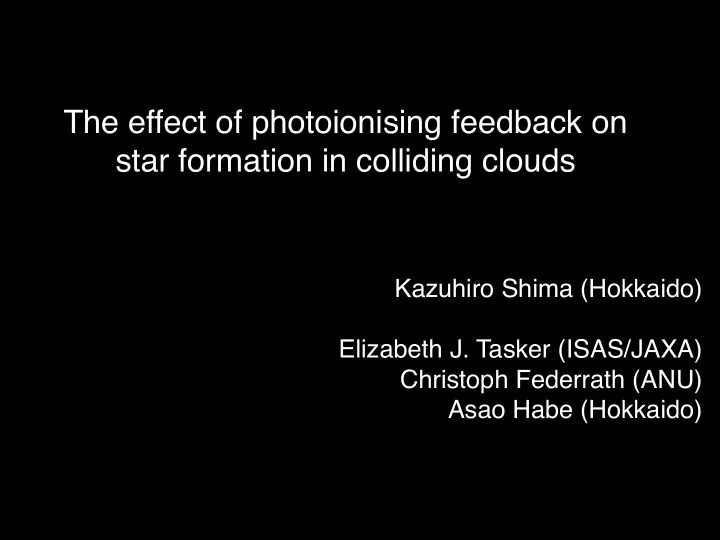

The effect of photoionising feedback on star formation in colliding clouds Kazuhiro Shima (Hokkaido) Elizabeth J. Tasker (ISAS/JAXA) Christoph Federrath (ANU) Asao Habe (Hokkaido)
INTRODUCTION
Star formation is important supernova UV radiation massive star return gas into ISM giant molecular cloud (GMC) Massive stars have important roles. -> How do massive stars form?
Cloud-Cloud Collision (CCC) scenario (Habe+Ohta 1992, Klein+Woods 1998, Anathpindika 2010, Inoue+Fukui 2013, Takahira+ 2014, Balfour+ 2015, Wu+ 2015,1016) GMC collision massive star massive core Gas is compressed at the collision interface. Massive cores will form.
Previous simulations (Takahira+ 2014) turb ) 3 / 2 M J,eff ∝ ( c 2 s + σ 2 √ ρ Jeans mass increase by turbulence in the shock.
Motivation collision massive star formation -> What happens to the cloud next? Massive stars emit larger quantities of UV photons. The energy will change the physical state of the cloud. -> (Next) star formation is affected.
Star formation and feedback giant molecular cloud (GMC) Star formation is controlled by the GMC’s state - self-gravity - turbulence - (magnetic fields) and feedback from other massive stars. Stars - massive stars emit large energy
Photoionisation feedback Ionization front 3 Q H ) 1 / 3 R s = ( 4 π n 2 H α B 1 t rec = n H α B Γ ph = k ph ( E ph − E ph ) HII region (ionised gas) molecular clouds gas ~ 10000 [K] >> ~ 10 [K] HII regions expand by high pressure.
Photoionisation feedback (test simulation) density slice plot Questions: enhance star formation? or surpress star formation? expanding hot shell turb ) 3 / 2 M J,eff ∝ ( c 2 s + σ 2 √ ρ massive star
NUMERICAL MODEL & METHODS
GMC model GMC dense core ~ 0.1 pc (10 15 m) ~100 pc (10 18 m) The dynamic range is very large.
simulation code Enzo; a 3D AMR code (Adaptive Mesh Refinement) (Bryan et al. 2014) Hydrodynamics is calculated on the meshes. Meshes are added adaptively over regions that require higher resolutions. (Enzo Workshop)
Star formation model GMC dense core stars ~ 10 9 m ~ 0.1 pc (10 15 m) ~100 pc (10 18 m) It is hard to resolve Individual stars. -> sink particle model.
Sink particle model sink formation conditions (Federrath et al. 2010) + the finest level of refinement + over density ρ gas > ρ crit + converging flow + gravitational potential minimum r = 0.07 pc φ center ≤ φ ( i, j, k ) r = 1 + Jeans instability check 2 λ J | E grav | > 2 E th λ J = 5 ∆ x ρ crit = π c 2 + bound state check s G λ 2 E grav + E th + E kin < 0 J
sinks feedback Feedback model GMC dense core UV radiation from massive stars Radiation is treated with ray-tracing method.
Adaptive ray tracing (Wise & Abel 2011) ections and splitting based The radiative transfer equation is solved along rays. Ionisation of hydrogen and the UV heating rate is calculated. Rays are split into child rays when the solid angle is large compared to the cell face area. (Enzo Workshop)
Initial conditions Surface density Colliding clouds Isolated cloud with 10, 20 km/s 1 . 1 × 10 4 M sun 5 . 5 × 10 4 M sun 4 . 4 × 10 4 M sun Box size: 90 pc Maximum refinement level: 5 Resolution: 0.03 pc
RESULTS
Isolated cloud (NoFeedback) Surface Density SFE v.s. Time Turbulence decays and the cloud begins to collapse. The SFE reaches ~ 2% at 6 Myr.
Colliding cloud at 10 km/s (NoFeedback) Surface Density SFE v.s. Time The colliding clouds begin star formation earlier. The SFE reaches 12 % at 6 Myr.
Colliding cloud at 20 km/s (NoFeedback) Surface Density SFE v.s. Time The faster collision produces stars more rapidly. The SFE reaches 17 % at 6 Myr.
Probability Distribution Function (PDF) of density turbulence -> log-normal PDF collapse -> tail Gas is compressed by collision.
Collision effect on star formation cumulative mass function isolated turb ) 3 / 2 M J,eff ∝ ( c 2 s + σ 2 10 km s − 1 10 3 √ ρ 20 km s − 1 fragment into small N ( < M ) 10 2 species 10 1 turb ) 3 / 2 M J,eff ∝ ( c 2 s + σ 2 10 0 √ ρ 10 − 2 10 − 1 10 0 10 1 M (M � ) more massive sinks more small & massive sinks
Feedback effect on star formation (colliding cloud) Surface Density SFE v.s. Time The effect is positive in the colliding clouds. The SFE reaches 23 % at 6 Myr.
Feedback effect on star formation (colliding cloud) Surface Density SFE v.s. Time The effect is positive in the colliding clouds. The SFE reaches 24 % at 6 Myr.
DISCUSSION
○ △ Why feedback is positive ? Density slice HII Density slice 2 3 high-mass star HII regions formed in the interface.
Why feedback is positive ? mass function less small sinks & more massive sinks -> fragmentation is suppressed
CONCLUSIONS
We made numerical simulations to study star formation in colliding cloud considering feedback. The colliding clouds promote star formation efficiency by a factor of 10 higher than the isolated cloud. The photoionising feedback increases the SFE in the colliding clouds. -> feedback is positive in colliding clouds!
Recommend
More recommend